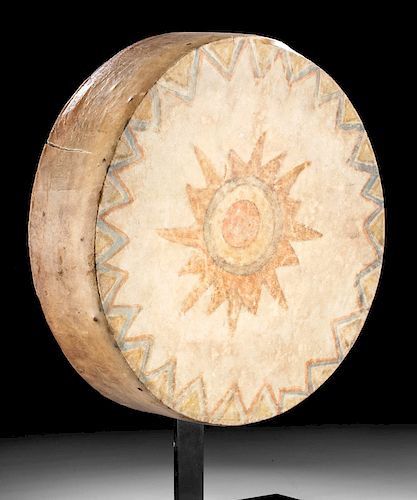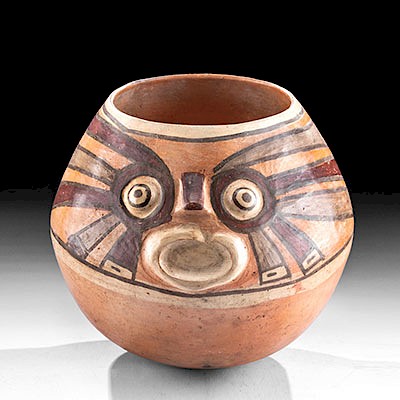Rare 19th C. Lakota Sioux Buffalo Hide & Wood Drum
Lot 128c
About Seller
Artemis Fine Arts
686 S Taylor Ave, Ste 106
Louisville, CO 80027
United States
Selling antiquities, ancient and ethnographic art online since 1993, Artemis Gallery specializes in Classical Antiquities (Egyptian, Greek, Roman, Near Eastern), Asian, Pre-Columbian, African / Tribal / Oceanographic art. Our extensive inventory includes pottery, stone, metal, wood, glass and textil...Read more
Estimate:
$8,000 - $12,000
Absentee vs Live bid
Two ways to bid:
- Leave a max absentee bid and the platform will bid on your behalf up to your maximum bid during the live auction.
- Bid live during the auction and your bids will be submitted real-time to the auctioneer.
Bid Increments
| Price | Bid Increment |
|---|---|
| $0 | $25 |
| $300 | $50 |
| $1,000 | $100 |
| $2,000 | $250 |
| $5,000 | $500 |
| $10,000 | $1,000 |
| $20,000 | $2,500 |
| $50,000 | $5,000 |
| $100,000 | $10,000 |
| $200,000 | $20,000 |
About Auction
By Artemis Fine Arts
Dec 5, 2019
Set Reminder
2019-12-05 10:00:00
2019-12-05 10:00:00
America/New_York
Bidsquare
Bidsquare : Ancient / Ethnographic - Holiday Edition
https://www.bidsquare.com/auctions/artemis-gallery/ancient-ethnographic---holiday-edition-4710
What to give this holiday season? Ancient & Ethnographic Art of course! Our special Holiday auction features hundreds of unique finds from all over the world. Artemis Fine Arts info@artemisfinearts.com
What to give this holiday season? Ancient & Ethnographic Art of course! Our special Holiday auction features hundreds of unique finds from all over the world. Artemis Fine Arts info@artemisfinearts.com
- Lot Description
Native American, Lakota Sioux tribe, modern day North and South Dakota, ca. 1870 to 1890 CE. A rare and gorgeously preserved hand drum, known as a "cancega", made from a cottonwood tree trunk with hand-scraped buffalo rawhide stretched over one open side. The face is painted with bright, earthy pigments - ocher yellow, deep blue, bright red, and orange - that, although time has somewhat faded them, remain clearly on the face. The artist painted a sunburst at the center and a series of triangles around the edges. Fascinatingly, "cancega" means "wooden bucket", a delightfully down-to-earth name for this important musical instrument. Size: 11" W x 3" H (27.9 cm x 7.6 cm); 14.95" H (38 cm) on included custom stand.
The cancega tradition is long and continues in the Lakota Sioux community today. The sound of the drum, often played using a tree branch, serves as a central, sacred point for tribal ceremonies and is treated with respect - some drums are even so important that the community will have a yearly festival with a feast to honor the drum, serving deer or buffalo, wild berries, corn, and water, with some of the food placed ceremonially near the drum. The hand drum is the smaller of the Lakota Sioux drums and is used in tighter, interior spaces such as inside a sweat lodge; a larger bass drum is used for a powwow or gathering. The player will use four basic rhythms to lead seven major dances. However, not all drum use is sacred and ceremonial. Pete McDonnell, interviewing Severt Young Bear, a traditional Lakota singer, learned that, "hand drums were often used in the home to accompany family members' signing, and that this home-based singing was a way for the family to connect with each other and to work through emotions--off happiness, sadness, anger-whatever the mood was at the time" (on McDonnell's blog "The Circle is a Circuit", January 19, 2009).
Provenance: Tambaran Gallery, New York, New York, USA, purchased from Craig Finch, London, UK, on March 12, 2014
All items legal to buy/sell under U.S. Statute covering cultural patrimony Code 2600, CHAPTER 14, and are guaranteed to be as described or your money back.
A Certificate of Authenticity will accompany all winning bids.
We ship worldwide and handle all shipping in-house for your convenience.
#149088A few tiny tears at the edges of the hide; there are also two tiny holes along the upper edge. Small stains and deposits are on the surface, mainly around the edges. The motifs are faded but still clear. Excellent patina on the hide.Condition
- Shipping Info
-
All shipping is handled in-house for your convenience. Your invoice from Artemis Gallery will include shipping calculation instructions. If in doubt, please inquire BEFORE bidding for estimated shipping costs for individual items.
-
- Buyer's Premium



 EUR
EUR CAD
CAD AUD
AUD GBP
GBP MXN
MXN HKD
HKD CNY
CNY MYR
MYR SEK
SEK SGD
SGD CHF
CHF THB
THB














